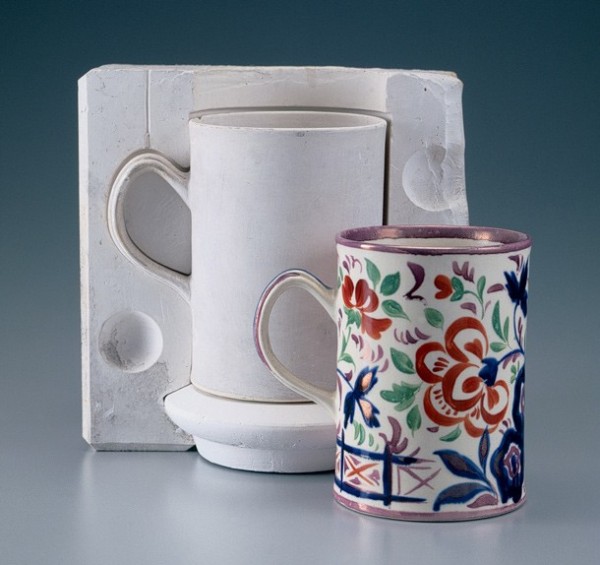
Mold, bisque mug, and finished mug, 1950–1970. Plaster of paris and whiteware. H. of bisque mug 4 3/4"; H. of finished 4 1/2". (Courtesy, White Hall Restaurant Collection; unless otherwise noted, all photos by Gavin Ashworth.)
It cannot be determined whether this mug, with its pure cylindrical form and loop handle, is copied from an eighteenth-century piece. There is no mug at Williamsburg of this exact form and size, nor is there any record of Thorley borrowing one to copy. It is most likely that Thorley designed this form based on his knowledge of eighteenth-century shapes and proportions. An eighteenth-century vessel of this shape would not have been cast in a mold, as this was, but rather thrown on a wheel, the handle either shaped by hand or pressed in a small, separate mold and then attached. The decoration on this mug is reminiscent of the ware he designed or adapted while he was designer at Allerton Ltd., Longton, England, from about 1924 until 1927, when he immigrated to the United States. (See Austin, “Thorley, Part 1,” pp. 179–81, figs. 31–34.) Thorley used the pink luster again during his latter days of production.
Unless otherwise noted, the illustrated items in this article were made by Palin Thorley, Williamsburg, Virginia, and are in the author’s collection.

Secondary sign that hung outside Thorley’s studio-shop, 1950s–1970s. The primary, much more elaborate sign that hung near the road illustrated a potter at his wheel. (See Austin, “Thorley, Part 1,” fig. 1.)
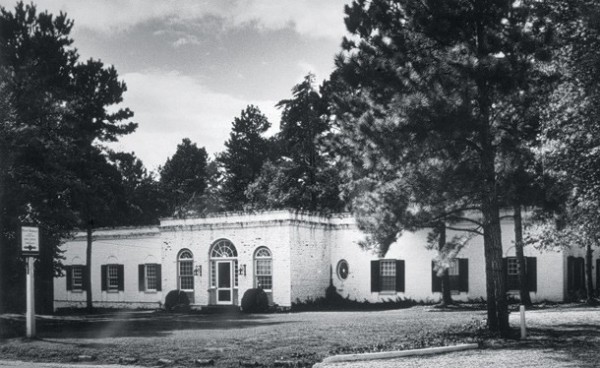
White Hall, as it appeared in the British trade magazine Pottery and Glass, November 1950, with the caption: “Studio, laboratory and oYces at Williamsburg, Virginia USA, built 1945–1950 by Joseph Palin Thorley for research on commercial ceramics processes and the reproduction of wares of historic interest to Williamsburg, under special licence from the authorities.”
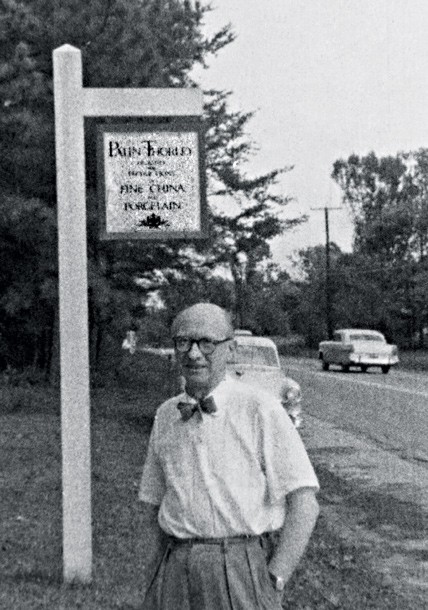
Palin Thorley standing beneath the sign that hung in front of White Hall until about 1956, when it was replaced with one illustrating a potter at his wheel.
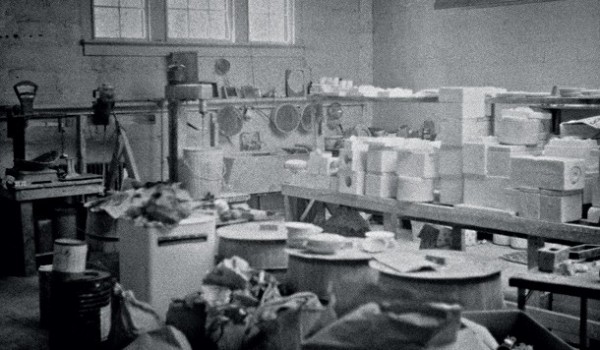
Interior of Thorley’s studio, 1964 or 1965, showing barrels, probably filled with slip, and stacks of plaster of paris molds.
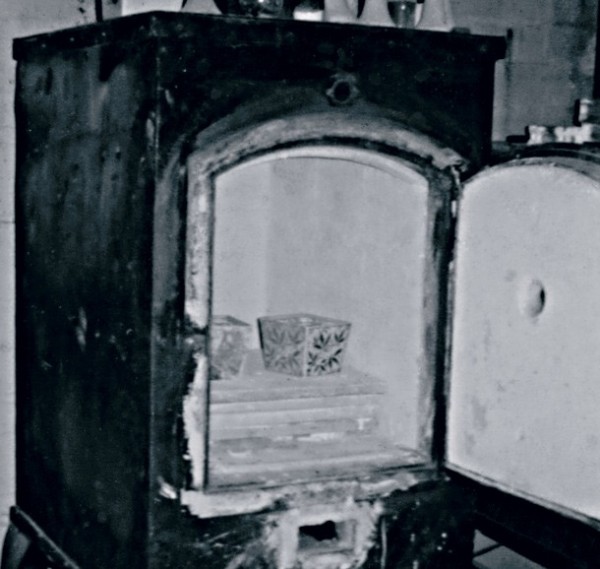
Gloss (glazing) kiln, 1970, with “square bricks” placed on a shelf inside.
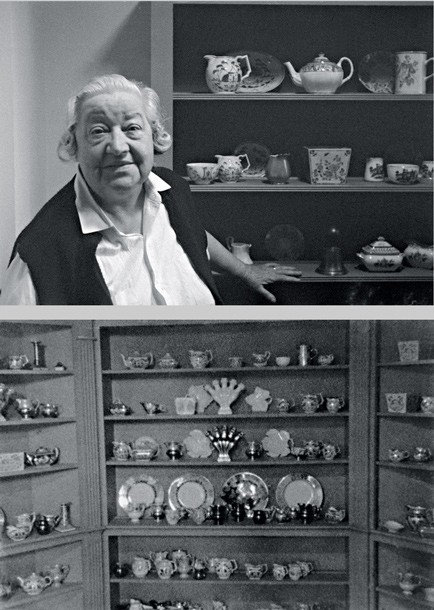
Edith Thorley in her shop, 1964 or 1965, and the interior of the shop, probably 1960s. Both pictures show forms developed for the Craft House that Thorley continued to make, examples made or decorated by Thorley after he stopped producing for Colonial Williamsburg, and unidentified objects that perhaps were designed by him earlier and still in production by the East Liverpool (Ohio) factories.
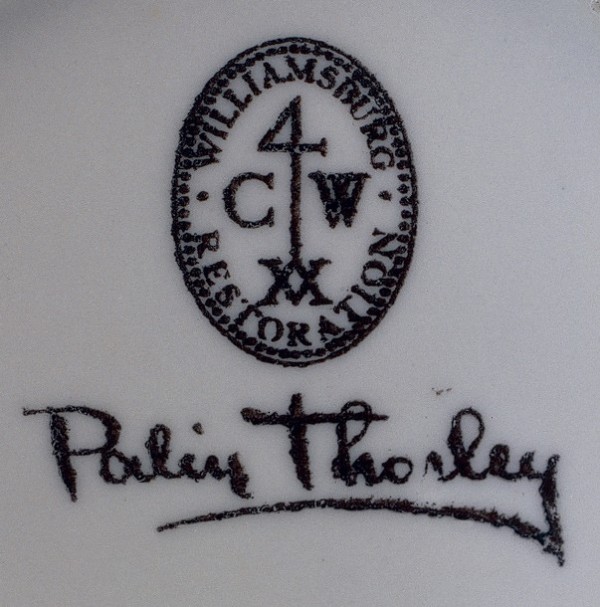
Printed mark used by Thorley on wares produced for the Craft House, Colonial Williamsburg’s merchandise outlet, between 1941 and 1956. All of Thorley’s forms that he produced for the Craft House—whether sold through this outlet or directly to other customers—bear this mark. The oval emblem is based on seventeenth- and eighteenth-century British shippers’ marks.
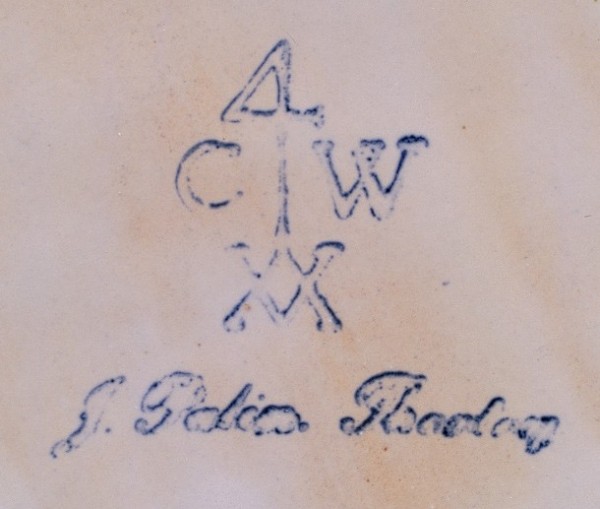
Rare variation of the Craft House/Thorley mark. This seems to appear only on the “GR” plate, which was produced between 1942 and 1945 (see fig. 52).
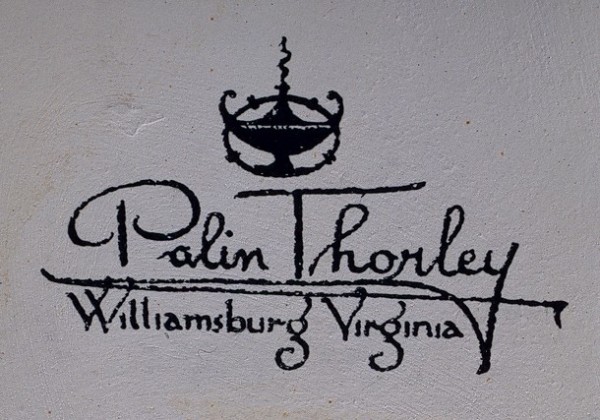
Thorley’s printed mark was registered in 1956. In the application he states that he used the mark as early as 1955; therefore, pieces with this mark must have been made between 1955 and the 1970s, when Thorley ceased producing. Objects with this mark and the oval Colonial Williamsburg mark are rare and were made in 1955 or 1956.

Examples of handwritten marks possibly used from 1949, when Thorley moved to Williamsburg, until the 1970s, when he stopped producing ceramics. His monogram, illustrated on the lower part with the red ground, is sometimes the only mark on a piece and dates the same as his full signature.

Page from Colonial Williamsburg’s Craft House Catalog, probably 1953 or 1954.
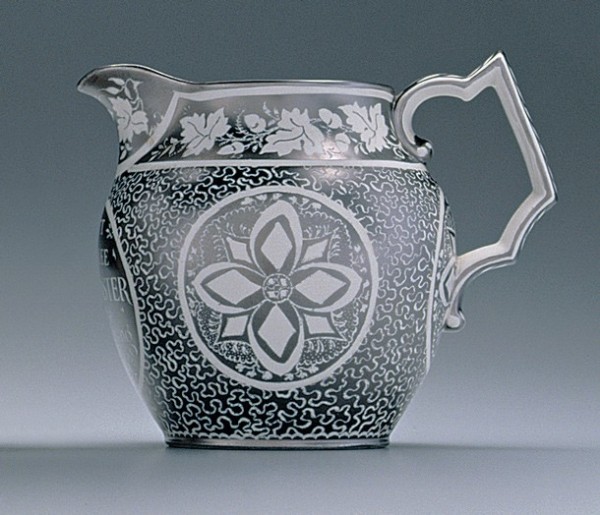
Silver resist jug, 1938–1956. Earthenware. H. 5 1/2". The dates indicate the year the piece was approved for reproduction and the last year it was produced for the Craft House. If a Thorley-made object bears the Williamsburg mark, it was made between those dates.
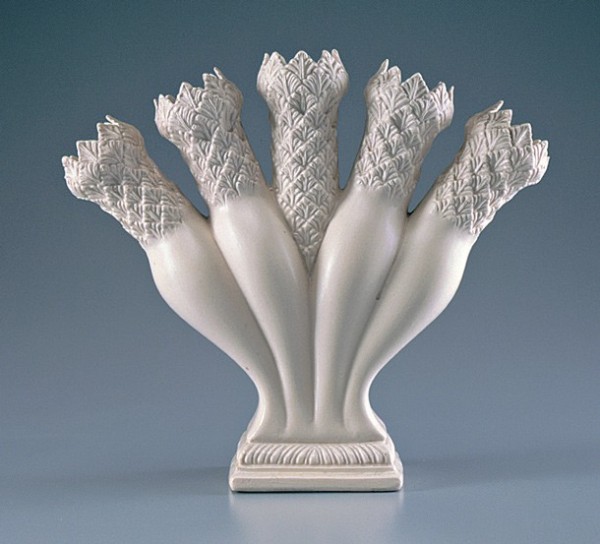
Posy holder. Earthenware. H. 8". Approved for reproduction in 1946, last produced for the Craft House in 1956.
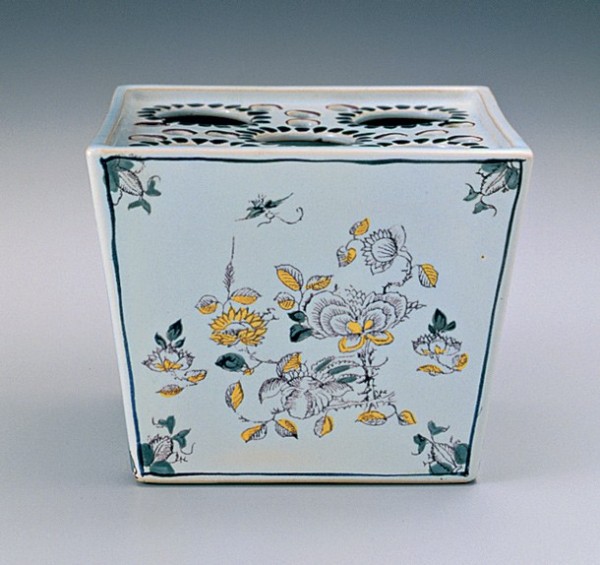
Jardiniere. Earthenware. H. 4". Approved for reproduction in 1942; last produced for the Craft House in 1955.
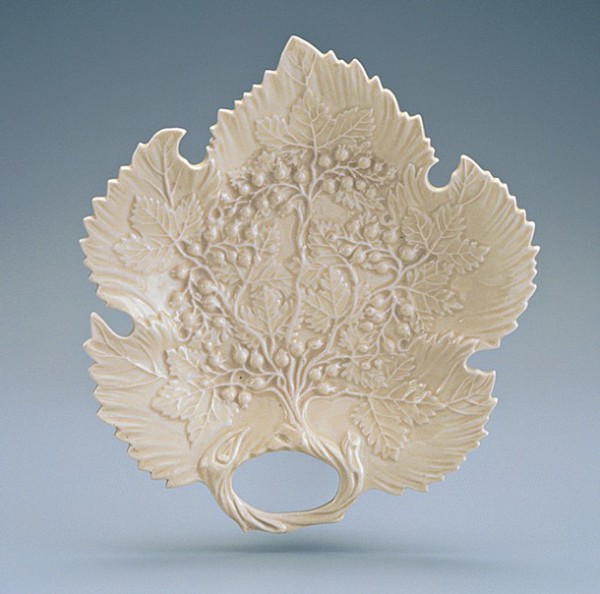
Sweetmeat dish. Earthenware. L. 8". Approved for reproduction in 1952; last produced for the Craft House in 1956.
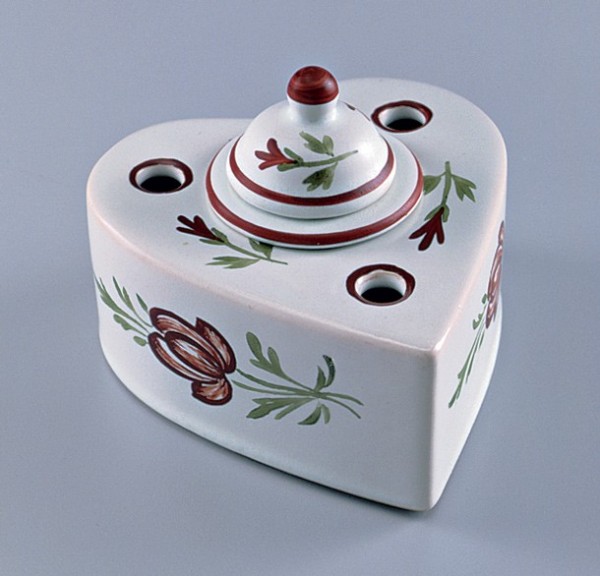
Inkstand. Earthenware. H. 4 1/2". Approved for reproduction in 1951; last produced for the Craft House in 1956.
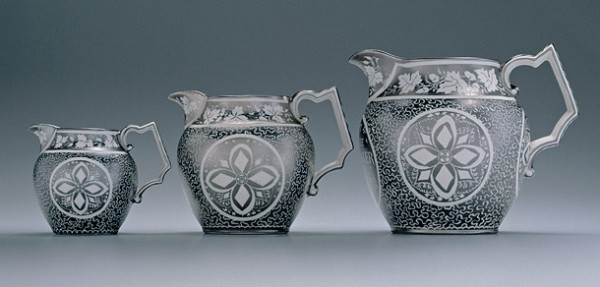
Thorley Jugs, 1945–1956. Earthenware. Left to right: H. 3", 4 1/2", and 5 1/2". These jugs were produced for the Craft House, and all bear the stamped “CW” logo and Thorley’s name.
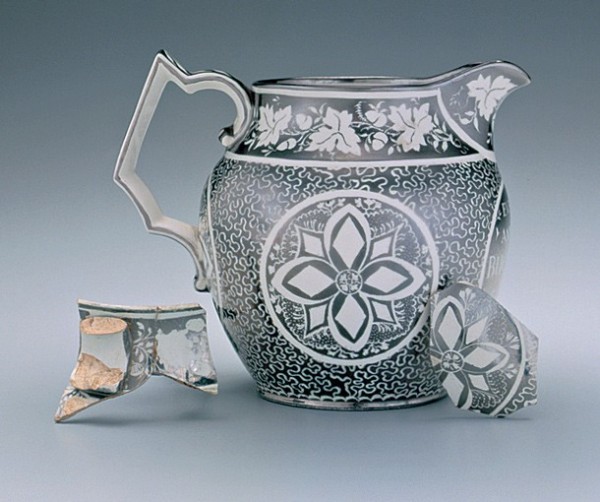
Silver luster jug and archaeological sherds from a similar, early-nineteenth-century jug excavated from the Donigan site, in Williamsburg (Windmill lot). Earthenware. H. of jug 5 1/2".
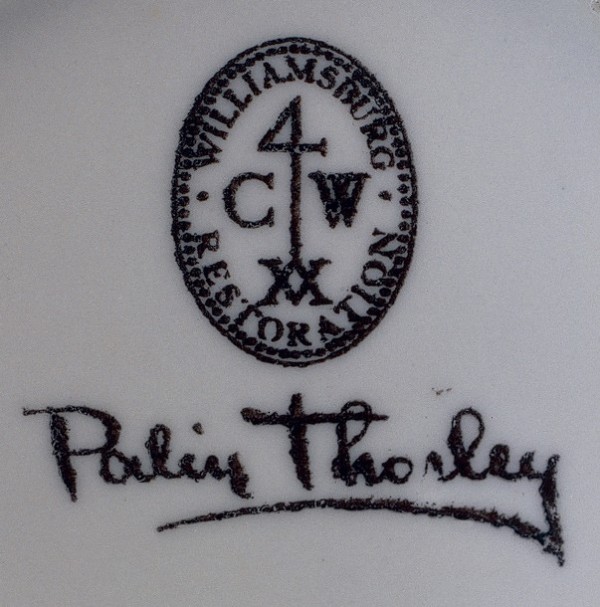
Thorley/Craft House mark on the jug illustrated in fig. 19. (Courtesy, Collins Collection.)
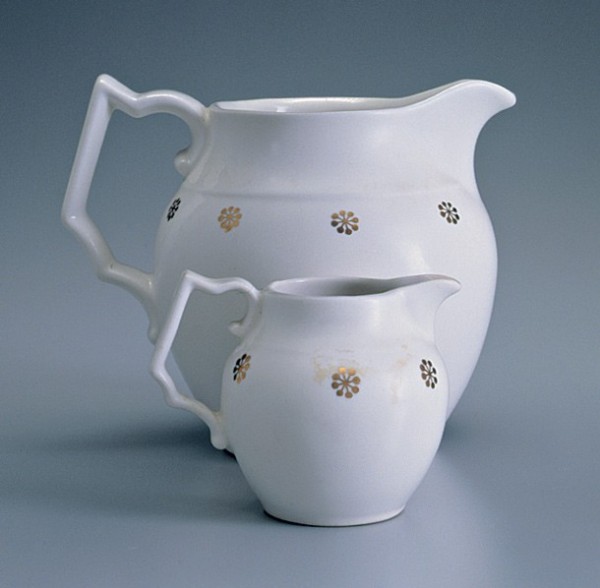
For comparison, the largest and the smallest of Hall China Co.’s Thorley Jugs. Earthenware H. 5 1/2", 3 1/4".

Thorley Jug, with tower decoration. Earthenware. H. 4 1/2". Thorley was producing objects for other outlets while he was making ware for the Craft House. A 1954 order from the Williamsburg Lodge gift shop included jugs in eight diVerent patterns, among them “Pink Luster tower pattern.” The motif on this unmarked pink luster jug was probably inspired by his work on eighteenth-century English delft.

Inscription on the bottom of the jug illustrated in fig. 24. The inscription is used infrequently; the numbers in blue suggest that the jug had been used earlier for experimental purposes.
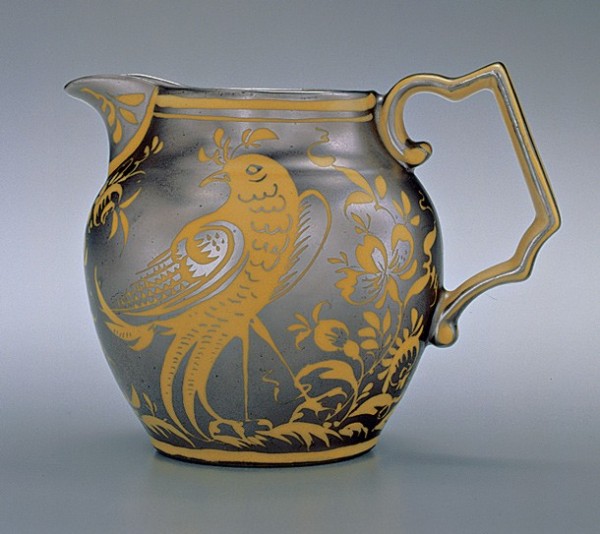
Silver and yellow luster jug, ca. 1960. Earthenware. H. 3 1/4". (Courtesy, Collins Collection.) The bird pattern is not common for Thorley commemorative wares. This jug is one of two inscribed for the Buckmaster family.
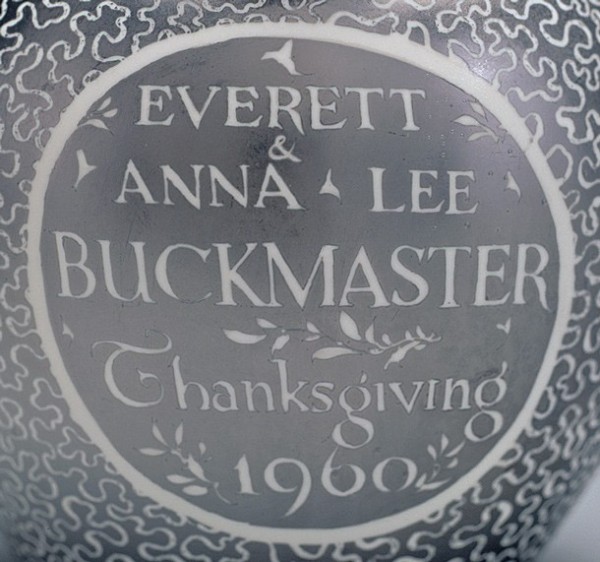
Inscription on a silver luster jug. (Courtesy, Collins Collection.) Inscriptions typically were placed on the side, like the rosette on the jugs illustrated in figs. 18 and 19.

Jug, dated 1967. Whiteware. H. 3 1/4". (Courtesy, Clark Taggart Collection.) Probably decorated as a Christmas present and never sold or given, this small Thorley jug was in Thorley’s possession in 1986. The inscription, “xm/as/1967,” is written in Old English script, popular in the 1920s and 1930s but used by Thorley on many experimental pieces and also found in drawings among his papers.
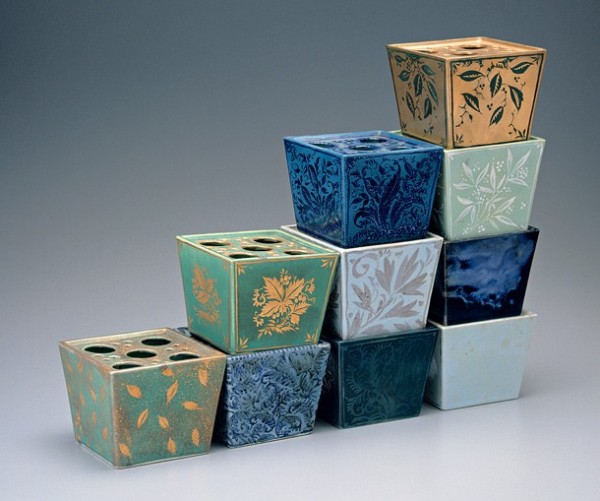
Jardinieres, or square bricks, 1946–1970. Earthenware. H. of each 4". This stack of jardinieres shows the variety of colors and designs used by Thorley.

Jardiniere, 1942–1956. Whiteware. H. 4". This brick is a well-executed, finished example. It does not bear a mark, as most production pieces would, but “#1” appears on a paper label aYxed to the bottom. It is possible that this, like the five-finger posy holder illustrated in fig. 41, is the sample that was presented to and approved by the Craft Advisory Committee of the Craft House. If so, its date of manufacture would be 1942; if not, between 1942 and 1956.

Jardiniere, 1942–1970. Earthenware. H. 4". This example illustrates an undecorated surface to which decoration could be added.
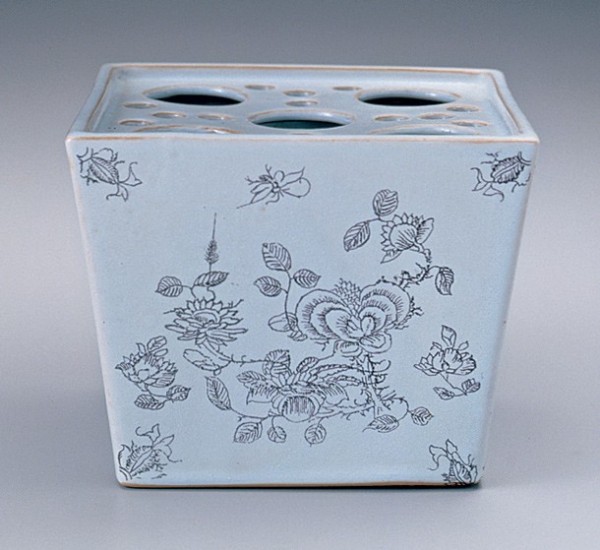
Jardiniere, 1942–1970. Earthenware. H. 4". Even though the eighteenth-century example from which this was copied was decorated by hand, the basic design of a reproduction was silk-screened and applied in monochrome—here, in manganese purple—and the piece was fired. Were the decoration painted entirely by hand, it would be impossible to produce the quantity necessary and still have the decoration as close to the original as required.
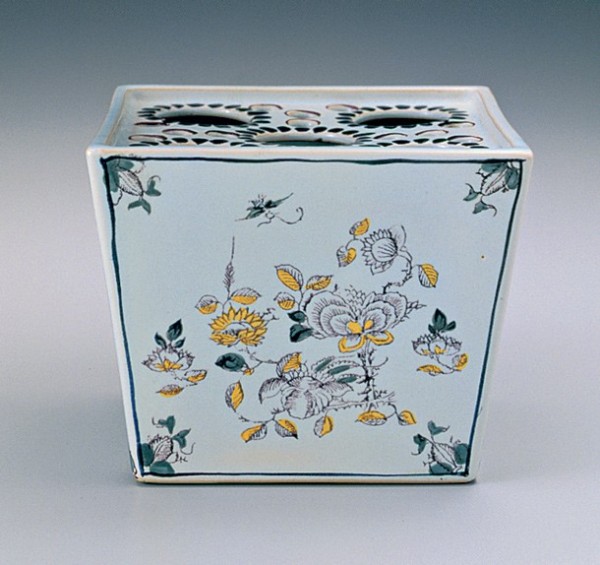
Jardiniere, 1942–1956. Earthenware. H. 4". (Courtesy, Collins Collection.) The yellow and blue decoration was painted by hand and the piece refired. As this bears the printed Craft House mark illustrated in fig. 8, it can be dated between 1942 and 1956.
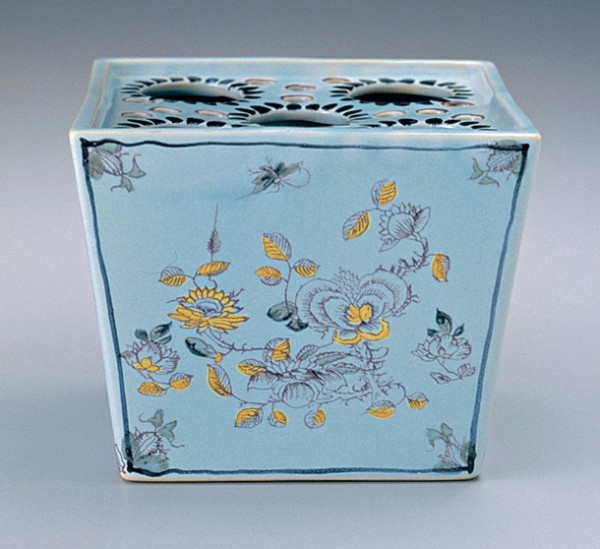
Jardiniere, after 1956. Earthenware. H. 4". Mark: Thorley stamp (illustrated in fig. 10). (Courtesy, Collins Collection.) This is a rare example of a reproduction made after 1956, when Thorley stopped producing for Colonial Williamsburg, as it bears Thorley’s printed mark, not the Colonial Williamsburg marks probably made shortly after that date.
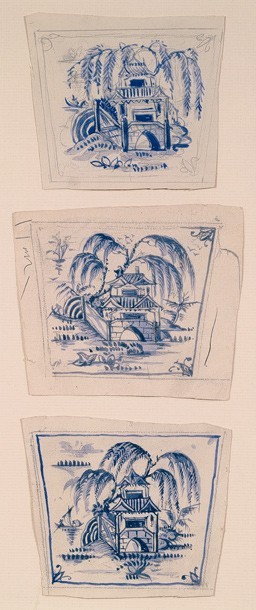
Drawings for jardinieres. Watercolor on paper. 7" x 16".
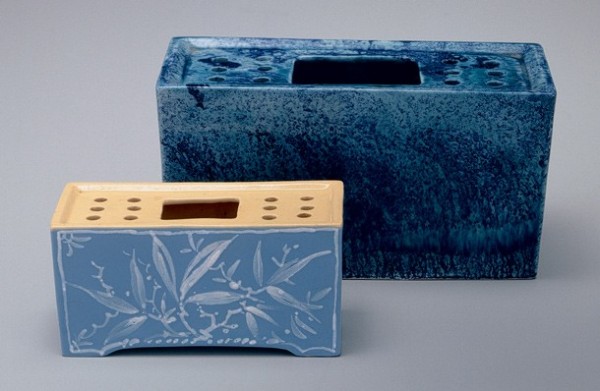
Flower bricks. Whiteware. Rear: 1955–1970. Mottled glaze. L. 7 1/2". Mark: Thorley stamp (illustrated in fig. 10). Front: 1942–1970. Foliated decoration. L. 5". Mark written in black and experiment mark in white.

Flower brick and jug, 1955–1970. Earthenware. Mark: Thorley stamp (illustrated in fig. 10). Brick: L. 7 1/8". Jug: H. 5 1/2". (Courtesy, Collins Collection.) Hand-painted with applied decal decoration.
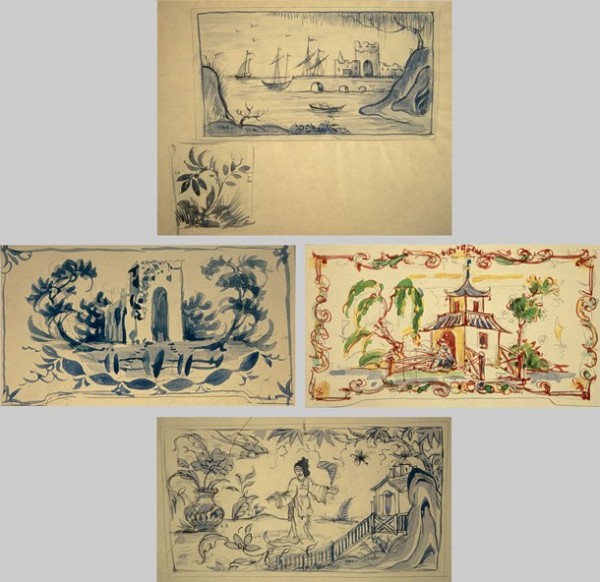
Drawings for flower bricks in the style of the eighteenth century, ca. 1954. Watercolor on paper. L. of images approx. 7". Probably intended to be used to decorate examples sold by Colonial Williamsburg. In 1954 Thorley presented to the Craft Advisory Committee hand-painted designs “in the spirit of” eighteenth-century style and technique, to be used on jardinieres. Even though one design was approved, none appears to have been produced and presented to the committee for approval.
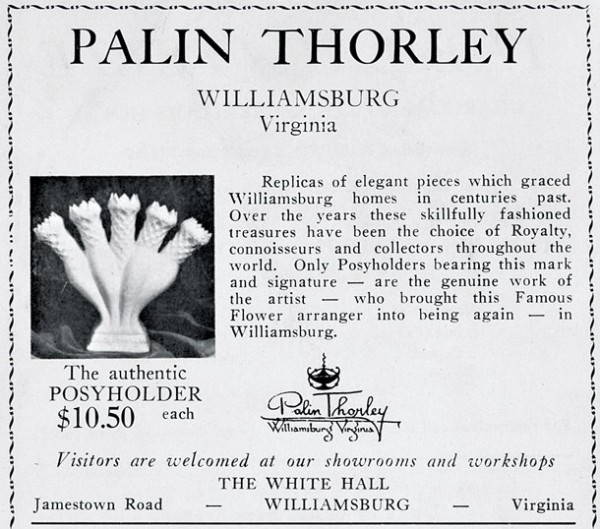
Palin Thorley’s most well-known reproduction was used to illustrate this advertisement for White Hall, the shop in Thorley’s pottery, which appeared in the 1959 Historic Virginia Week in Williamsburg catalog. At this time Thorley was still producing the form for his own sales; Wedgwood was producing it for Colonial Williamsburg.
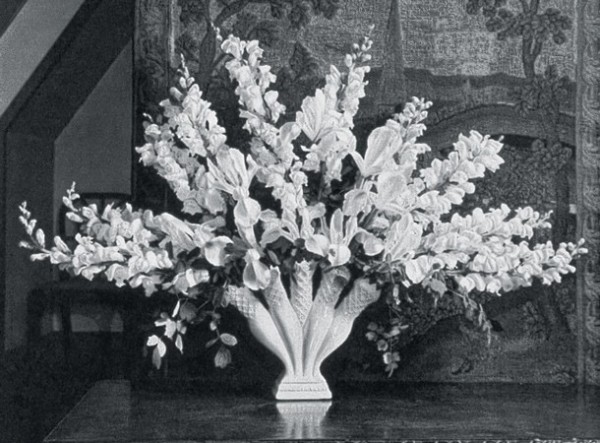
An illustration showing a Palin Thorley posy holder in use, in Louise Bang Fisher, An Eighteenth-Century Garland: The Flower and Fruit Arrangements of Colonial Williamsburg (Williamsburg, Va.: Colonial Williamsburg, 1951), sixth page insert between pp. 26 and 27.
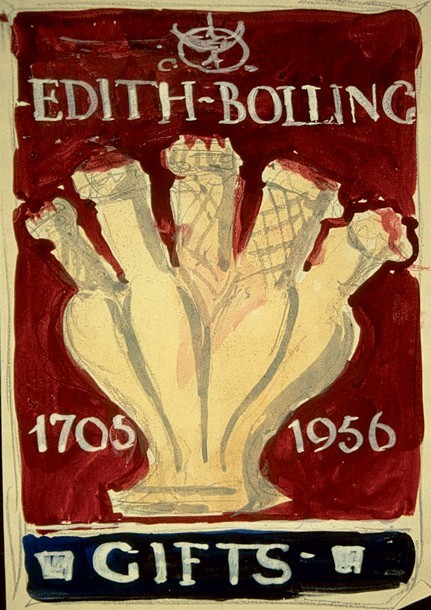
Shop sign design, 1956. Paint on paper. Approx. 18" x 24". (Swem Library, College of William and Mary.) In 1956 Thorley considered naming the shop for his wife, Edith, who managed it. He designed a sign incorporating the posy holder, which he eventually replaced with the “potter at his wheel” sign for which he is best known (see Austin, “Thorley, Part 1,” fig. 1).

Base of manufacturer’s model for the posy holder illustrated in fig. 41. Inscribed in pencil on the base: “This Sample Approved by Craft Advisory Committee on July 5, 1946. JAU.” The initials JAU refer to John (“Jack”) A. Upshir, who was in charge of the Craft House during Thorley’s tenure.
It was customary for the Craft House to require the licensed manufacturers to present to the Craft Advisory Committee two examples of each object to be produced. When a product was approved, one example remained with the committee and the other stayed with the manufacturer. This helped to ensure that the merchandise did not vary from the accepted model. Few of these accepted models have survived.

Posy holder, 1946. Creamware. H. 8". This is the original model produced by Thorley after an eighteenth-century example in Colonial Williamsburg’s collection. This was used as a guide by Thorley for the hundreds more he made during his productive life.
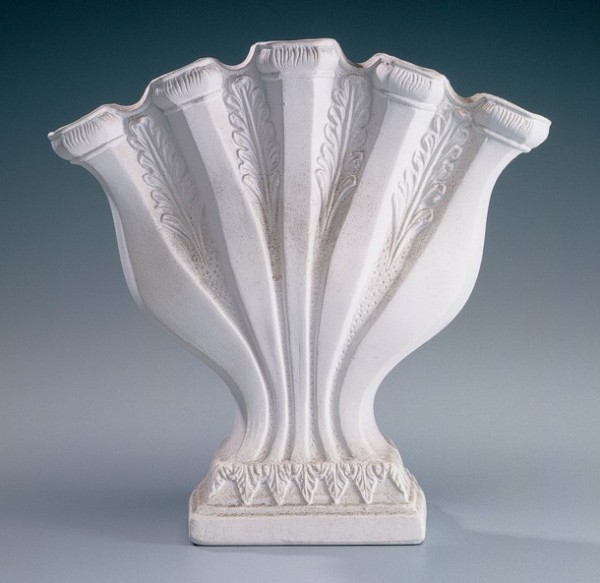
Posy holder model, 1955–1970. Earthenware. H. 7 1/2". Mark: Thorley stamp (illustrated in fig. 10). Fired once and never glazed, this vase is one half inch taller than it would have been had it been glazed and refired. This model is very much like colorful early-nineteenth-century examples. Although never produced for the Craft House, it might have been copied from a related antique example in Colonial Williamsburg’s collection. The Thorley Papers show that one was returned to Colonial Williamsburg in the 1950s.
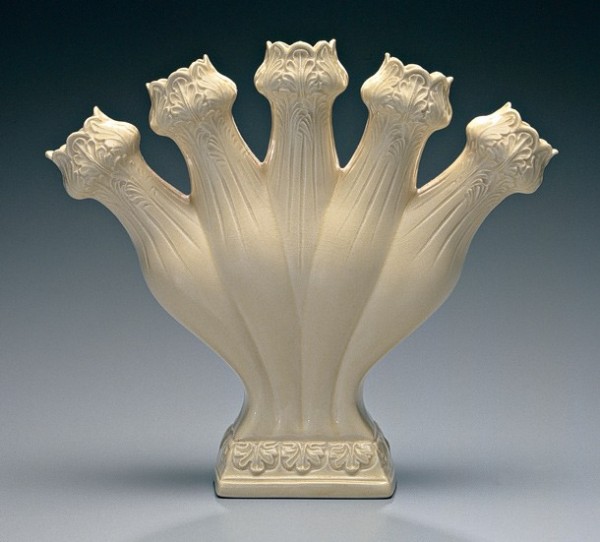
Posy holder, 1950–1970. Creamware. H. 8". Mark: In script, “Palin Thorley / Williamsburg.” (Courtesy, Collins Collection.) A simplified version of the Colonial Williamsburg example, this is the third form of the five-finger vase produced by Thorley. It may have been inspired by or copied from an eighteenth-century example.

Leaf-shaped sweetmeat dish, 1956–1970. Creamware. L. 8". Mark: Thorley stamp (illustrated in fig. 10). (Courtesy, Peter and Jean Brown Collection.)
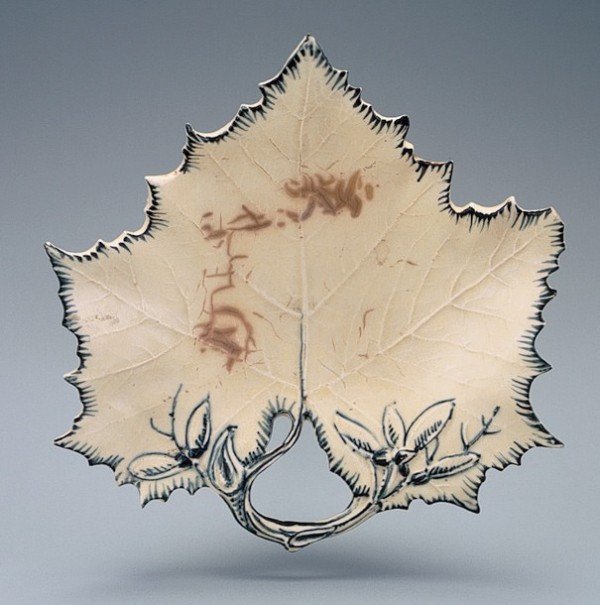
Sycamore leaf dish, 1955–1970. Whiteware. L. 7". Mark: Thorley stamp (illustrated in fig. 10).

Ivy or vine leaf dish, 1955–1970. Whiteware. L. 6". Mark: Thorley stamp (illustrated in fig. 10).
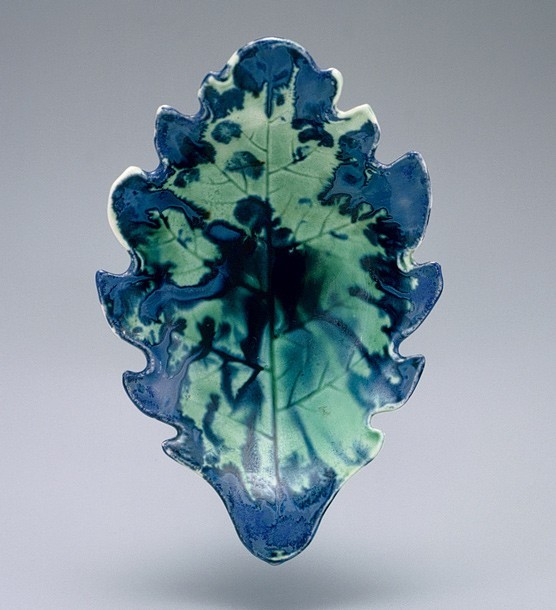
Oak leaf dish, 1955–1970. Whiteware. L. 6". Mark: Thorley stamp (illustrated in fig. 10).

Inkstand, 1952. Whiteware. W. 4 1/2". (Courtesy, Moyles Collection.) Mark: Thorley Craft House (illustrated in fig. 8). Inscribed, on base: “Tom Moyles of Williamsburg 1952.” This example was made for Thomas Moyles, director of the Williamsburg Inn and a personal friend of Thorley. It is the earliest recorded Thorley presentation piece.
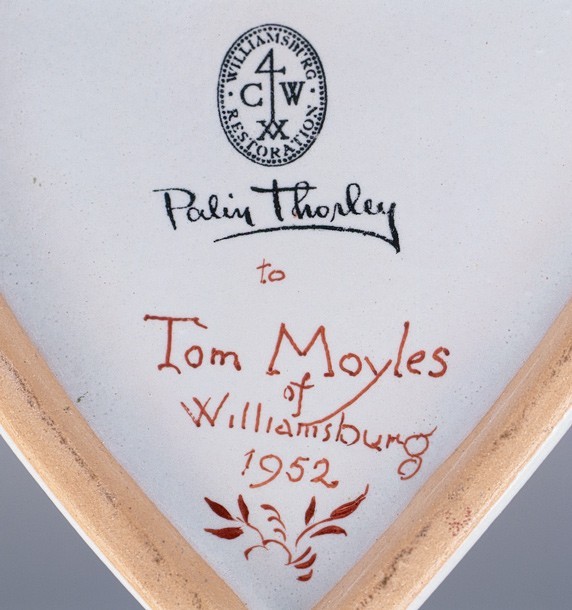
Mark and inscription on the underside of the inkstand illustrated in fig. 48.

A plaster of paris mold for slip casting a heart-shaped inkstand, 1951–1970. A once-fired but unglazed example showing its three parts, and a finished example, glazed and decorated in a non–eighteenth-century design.
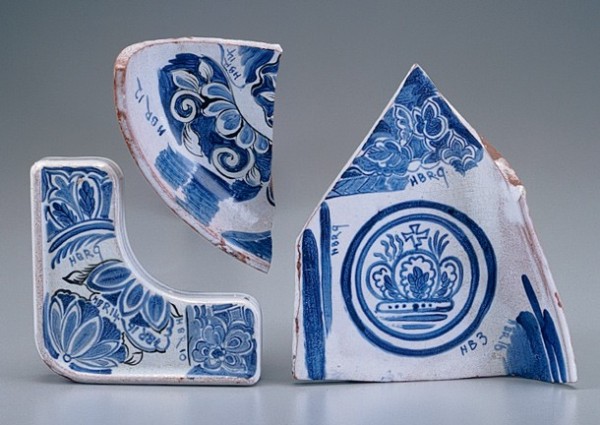
Three delft-like fragments, ca. 1942. These fragments show a crude dark red earthenware body and are covered with an opaque glaze. Thorley experimented with reproducing delft for Colonial Williamsburg, using his extensive knowledge of eighteenth-century English pottery.
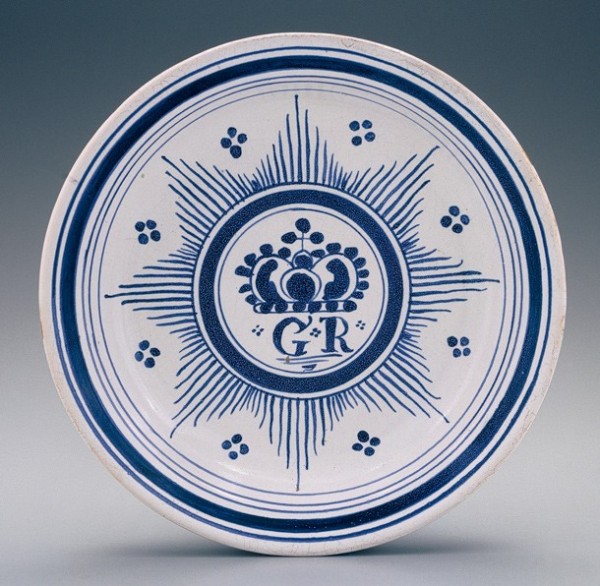
Plate, 1942–1945. Whiteware. D. 9". Mark: variation of the Colonial Williamsburg Craft House mark illustrated in fig. 8. (Courtesy, Colonial Williamsburg Collection.) This plate, reproduced from an eighteenth-century delft example, is listed in the Craft House price list only once (1942–1945) and does not appear in any of the catalogs. It is possible that it was produced for a very short time or that it was sold through other Colonial Williamsburg outlets; ointment pots such as the one illustrated in fig. 57, for example, were sold at the Galt Apothecary shop. The 1942–1945 price list for the Craft House catalog lists it as “Lambeth Delft Plate (blue & white)” with no mention of the “GR” cipher. The fragments illustrated in fig. 51 show related decoration, and the plates illustrated in figs. 54 and 55 are from the same mold. The original “GR” plate was made in England between 1714 and 1727 to honor King George I, who ruled Britain and the American colonies.

Detail of the mark on the underside of the plate illustrated in fig. 52. The significance of this rare version of the Craft House mark is unknown. It does not appear on the usual production.

Plate, 1942–1950. Whiteware. D. 9". Mark: experimental mark only. Thorley appears to have experimented on this plate using motifs usually found on eighteenth-century delft tiles.
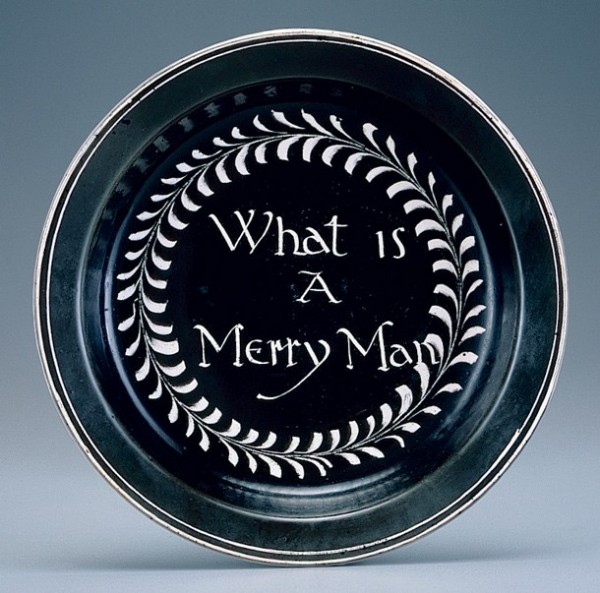
“Merry Man” plate, 1943–1950. Whiteware. D. 9". Unmarked. The source for the inspiration for this plate is unknown, as it dates from the 1940s and Colonial Williamsburg did not acquire its set of Merry Man plates until 1962. The verse, one line of which is displayed on each of six plates, reads: “What is a Merry Man, / Let him do what he can, / To entertain his guests, / With wine and merry gests, / But if his wife do frown, / All Merryment goes down.” The rhyme is from the seventeenth century, although dated antique examples of this wreath version range from 1717 to 1745
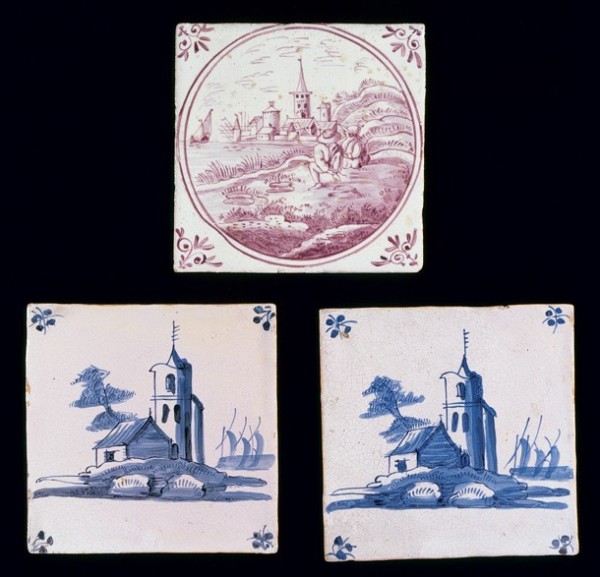
Tiles, 1942–1955. Whiteware. 5" x 5". Marks: experimental marks only. Hand-painted scenes in the eighteenth-century delft manner.
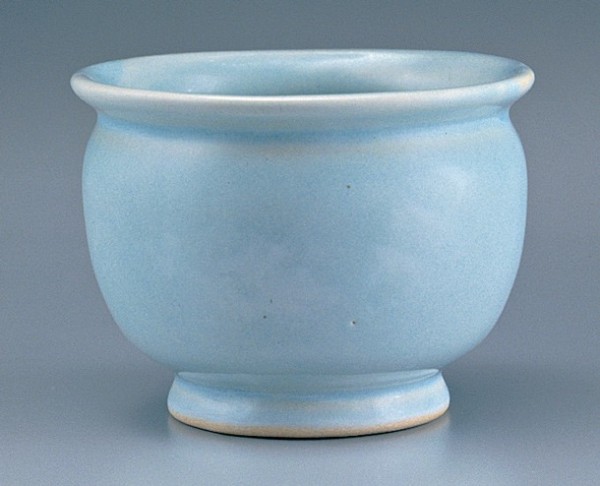
Ointment pot, 1955–1965. Earthenware, with Thorley’s original glaze. H. 2 1/4". Mark: Thorley stamp (illustrated in fig. 10). (Courtesy, Moyles Collection.)
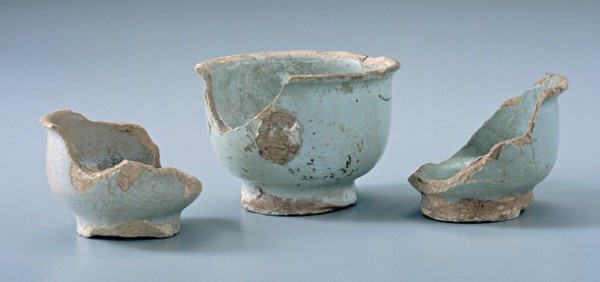
Ointment pots, England,
eighteenth century. Tin-glazed earthenware. H. of center pot 2". These archaeological sherds, excavated in Williamsburg and loaned to Thorley in 1940 as examples of the opaque delft glaze, eventually became prototypes for his ointment pot. They were found in his studio in 1986 and subsequently returned to Colonial Williamsburg.
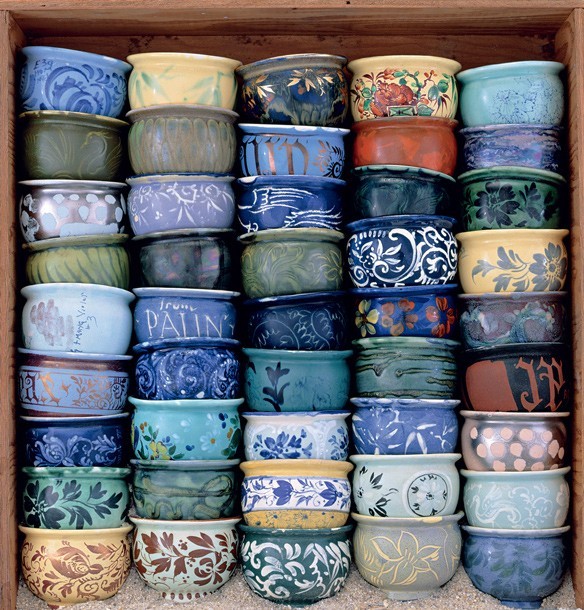
Ointment pots, 1954–1970. Whiteware. H. of pot 2 1/2". These pots were decorated by Thorley and used for experiments and gifts.

Plates with unfired decoration, 1951–1952. Whiteware. D. 10 1/2".
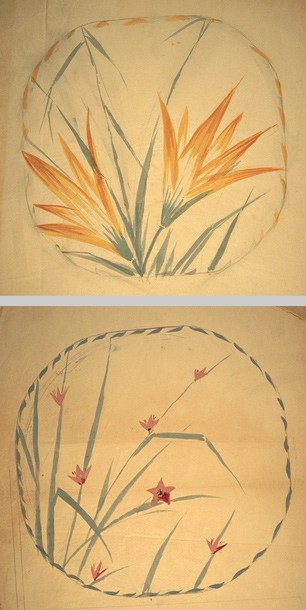
Drawings for the plates illustrated in fig. 60. Paint on paper.
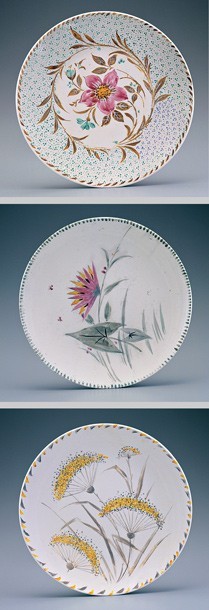
Plates with unfired decoration, 1951–1952. Whiteware. D. 10 1/2".
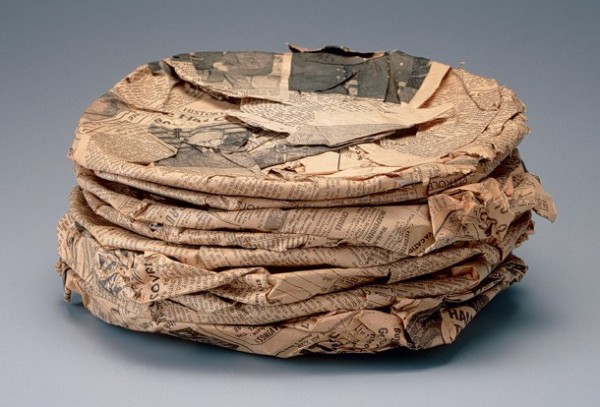
Stack of plates with unfired decoration still wrapped in local newspapers dated March and April 1952.

Figure, 1955–1970. Whiteware. H. 11". Glazed but undecorated figure of a lady in eighteenth-century dress, Mark: Thorley stamp (illustrated in fig. 10). (Courtesy, Tetrault Collection.) The figure has separated from its base.
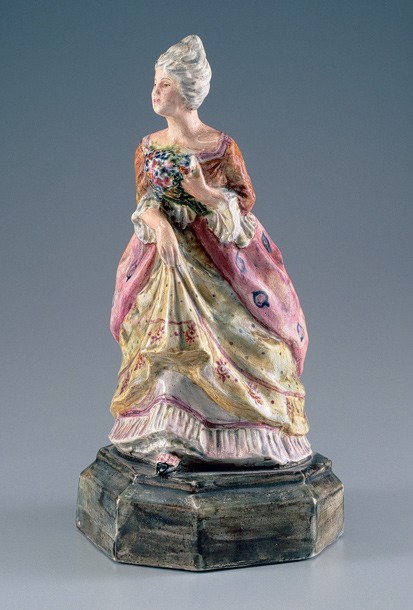
Figure, 1955–1970. Whiteware. H. 11". Unmarked. This is the same figure as that illustrated in fig. 64, but it is decorated in polychrome colors.
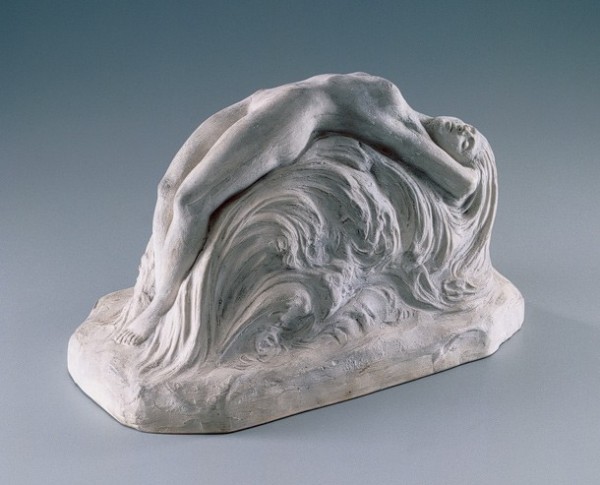
Unglazed figure of a reclining nude, 1930–1960. Earthenware. L. 10". Unmarked. (Courtesy, Tetrault Collection.)
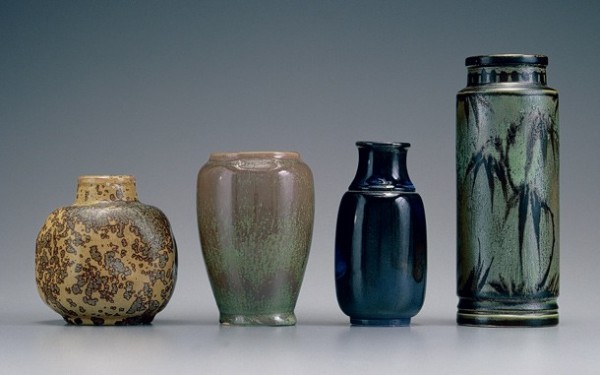
Left to right: Bottle, thrown with sides pushed in, 1955–1970. Stone- or earthenware. H. 4". Unmarked. This piece probably was not made by Thorley and might not have been decorated by him.Vase, thrown, 1955–1970. Earthenware. H. 4 1/2". Marks: experimental. Probably not made by Thorley but perhaps decorated by him. Bottle, molded, 1955–1970. Earthenware. H. 4 3/4". Marks: experimental numbers and handwritten “Palin Thorley / Williamsburg.” Vase, molded, 1955–1970. Earthenware. H. 7 1/2". Marks: experimental numbers and handwritten “Palin Thorley / Williamsburg.”

Left to right: Vase, molded, 1955–1970. Earthenware. H: 4 1/2". Mark: Thorley stamp (illustrated in fig. 10). Bottle, molded, 1955–1970. Earthenware. H: 4 3/4". Marks: experiment numbers and handwritten “Palin Thorley.” Vase, thrown, 1955–1970. Stone- or earthenware. H. 7 1/4". Unmarked. The vase was probably not made by Thorley but was perhaps decorated by him. The same hands appear to have made and decorated both it and the vase illustrated in fig. 67, second from the left.
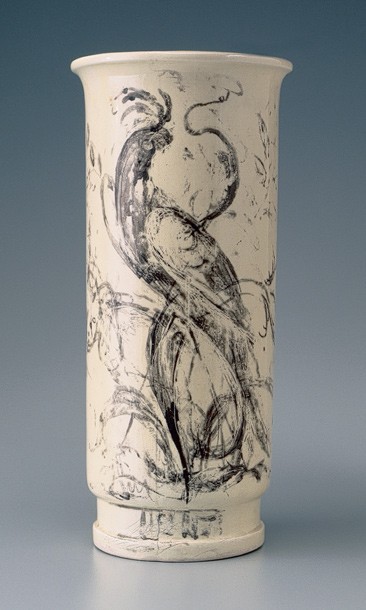
Vase, 1955–1970. H. 9". Mark: Thorley stamp (illustrated in fig. 10). One of two vases, from the same mold, found at Thorley’s studio. They were fired twice and have a clear creamy ground. Thorley decorated both in black, with exotic birds, but they were not fired again. This example is in far better condition than the other, although it shows some loss due
to handling.
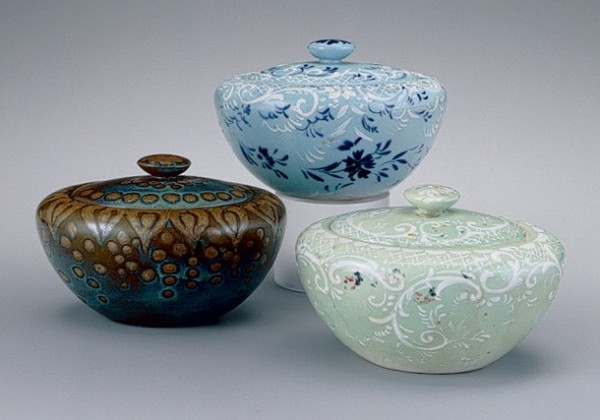
Covered containers, 1950–1970. Whiteware. L. 7". Marks: the brown example is unmarked; the other two have experimental numerals only. The poor quality of the body of these covered containers suggests that they were not made by Thorley. They were, however, decorated by him. The two on the right show the influence of eighteenth-century ceramics, where a thick white enamel is placed over a pale-colored ground, often giving the appearance of damask—a technique known as bianco supra bianco.

Bowls, 1950–1970. Top: Stoneware or possibly porcelain. H. 2". Mark: in script on bottom, “3c5 Thorley.” Lower left: Whiteware. H. 1 1/2". Marks: experimental marks only. Lower right: Whiteware. H. 2". Mark: in script on bottom: “Palin Thorley.” Thorley must have acquired many small bowls, roughly the size of a modern teacup, on which to try his experiments. Although he may have molded some of the bowls, few are duplicates, and they range from what appears to be Chinese hard-paste porcelain to crude earthenware. No molds or unglazed examples have been found.

Vases. Left: 1955–1970. Earthenware. H. 7 3/4". Right: 1950–1970. Earthenware. H. 7 1/2". One might think that these unusual modern-shaped vases were not molded by Thorley were it not for the fact that the white example is still in biscuit and bears the Thorley stamp (illustrated in fig. 10) while still in its green or unfired state.
The lustrous blue vase was a successful experiment in that its condition is good enough to have appeared in his shop. Only the series of numerals on the base explains that it was indeed experimental. His name, handwritten, also appears on the bottom.
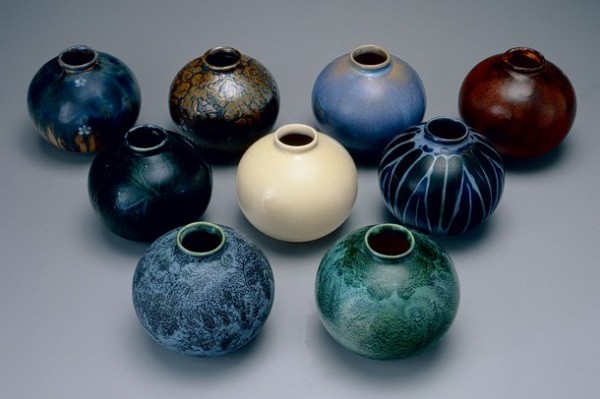
Vases, 1950–1970. Whiteware. H. 4 1/4". Many of these globular vases were found in Thorley’s studio. Some—bearing printed or handwritten marks—were ready to be sold, whereas others were experimental pieces, showing only the numerals and letters of the formula he was trying. Also found was a master mold (a positive mold in plaster of paris that looks like a larger but solid version of the final piece) and an example that had been fired once, marked, and covered with a coat of glaze not yet fired.

Green and gold objects, 1950–1970. Earthenware. Marks: handwritten, in gold, “Palin Thorley / Williamsburg.” Vase: H. 4 1/4". Large bowl: H. 1 1/2", D. 7 1/2". Small bowls: H. 1 1/4", D. 5 1/2".
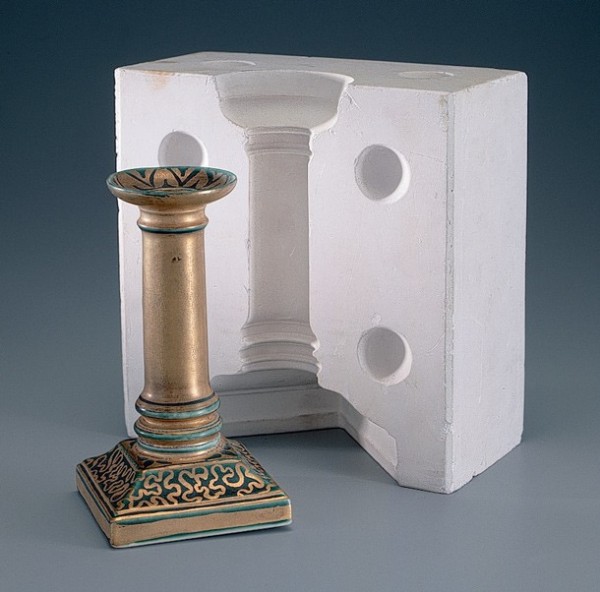
Candlestick, 1950–1970. Whiteware. H. 6". (Courtesy, White Hall Restaurant Collection.) Mark: handwritten, in gold, “Palin Thorley.” The candlestick is shown with a plaster of paris mold.
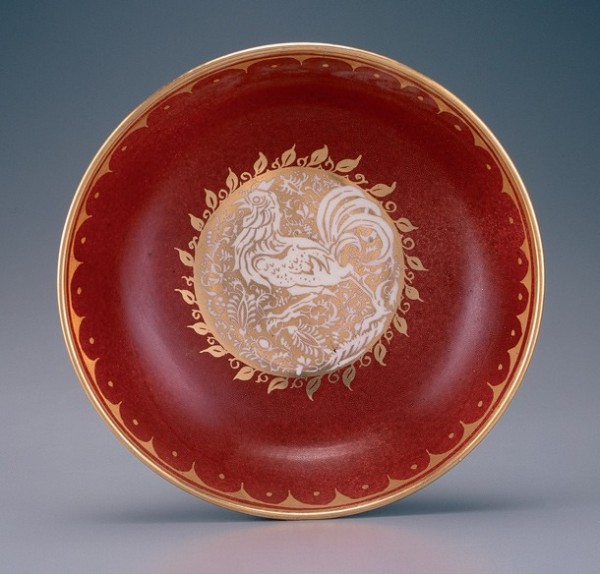
Bowl, 1950–1970. Whiteware. D. 9". Mark: handwritten “Palin Thorley/ Williamsburg / Virginia” and his monogram (see fig. 77). Thorley placed a very shiny ground color on both sides of this bowl, leaving a white reserve only on the interior bottom. The gold is quite lustrous and appears to have been burnished.
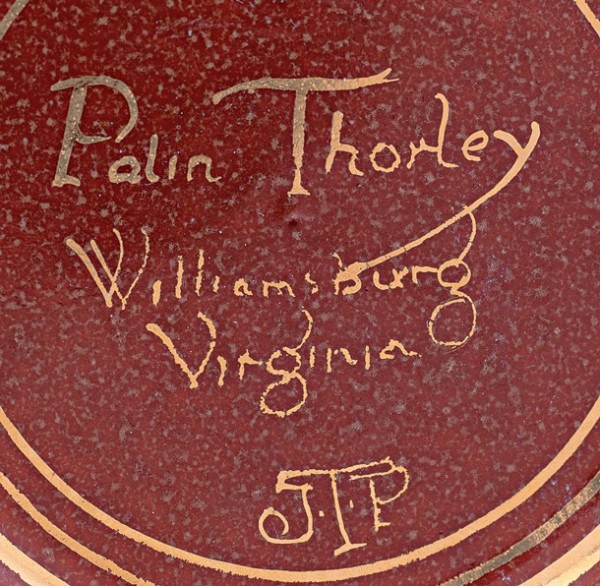
Mark and monogram on the underside of the bowl illustrated in fig. 76.
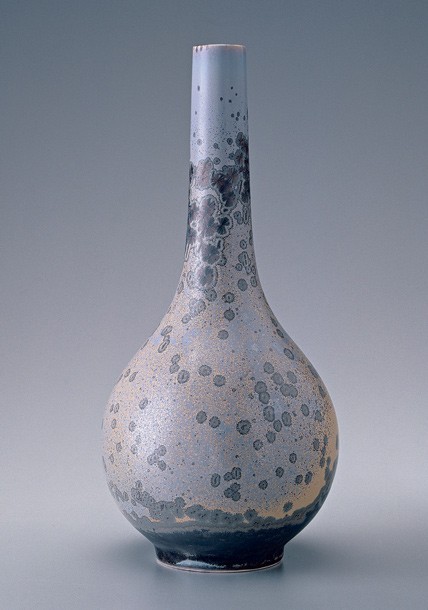
Vase, 1960–1970. Whiteware, with crystalline glaze. H. 9 3/4". Marks: experimental only. This tall vase might not have been made by Thorley, but it was decorated by him.
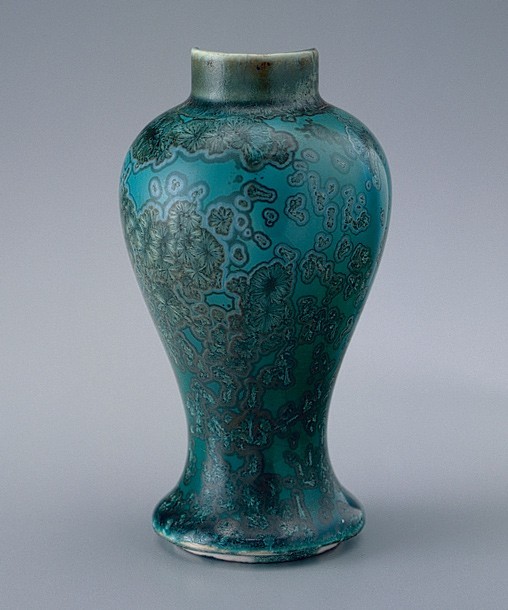
Vase, 1960–1970. Whiteware, with crystalline glaze. H. 5". Marks: experimental only. This vase might not have been made by Thorley but probably was decorated by him.

Plates, 1960–1970. Whiteware, with crystalline glaze. D. 6". Three examples from a large series of bread-and-butter plates from Thorley’s studio. All are bisque (that is, unglazed) on the reverse and bear the series number “rc-10,” with another number that diVers according to the glaze.

Copper luster jugs and posy holder, 1960–1970. Earthenware. Jugs: H. 4 1/2". Unmarked. Posy holder: H. 7". Mark: handwritten, mostly hidden under the dark glaze, “Palin Thorley / Williamsburg.”

Pink luster lamp base, 1960–1970. Whiteware. H. 12". Mark: handwritten, in pink, “Palin Thorley / Williamsburg Virginia.”
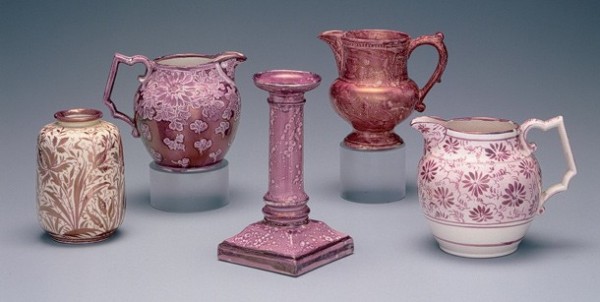
Five pink luster pieces made and decorated by Thorley, 1960–1970. Vase: H. 4 1/2". Marks: Thorley stamp (illustrated in fig. 10). Jugs in back: H. 4 1/2". Mark: handwritten, in pink, “Williamsburg,” and Thorley’s monogram. Candlestick: H. 6". Unmarked. Jug at right: H. 4 1/2". Mark: Thorley stamp (illustrated in fig. 10).
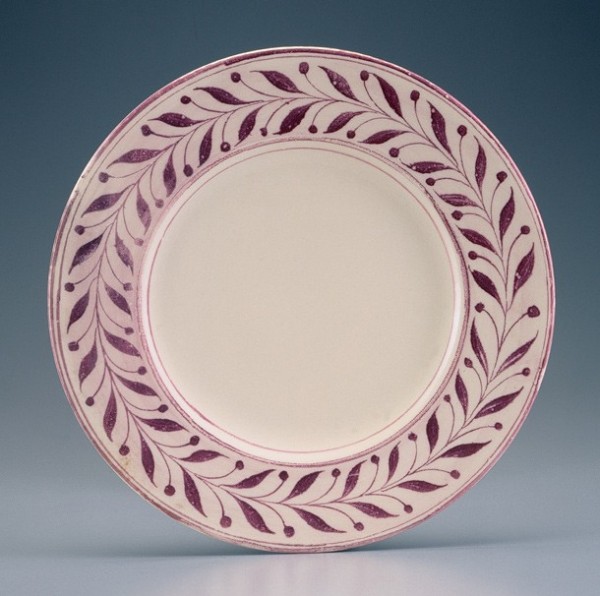
Pink luster plate, 1960–1970. Bone china. D. 10". Mark: handwritten, in pink, “Palin Thorley / Williamsburg.” Although not made by Thorley, this plate was decorated and signed by him.
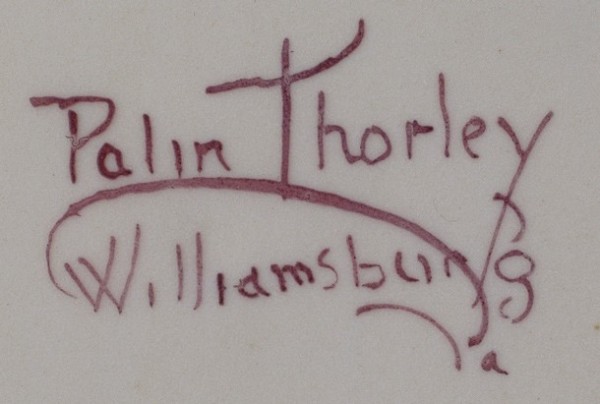
Mark on the underside of the plate illustrated in fig. 84.

Silver luster objects, 1960–1970. Earthenware, with silver on a yellow ground. Left to right: Thorley Jug: H. 4 1/2". Mark: Thorley stamp (illustrated in fig. 10). Vase: H. 5". Marks: handwritten, in red, “Palin Thorley / Williamsburg / Va.” Posy holder: H. 7". Mark: handwritten, in red, “Palin Thorley / Williamsburg / Va.” Thorley Jug: H. 4 1/2". Mark: Thorley stamp (illustrated in fig. 10).
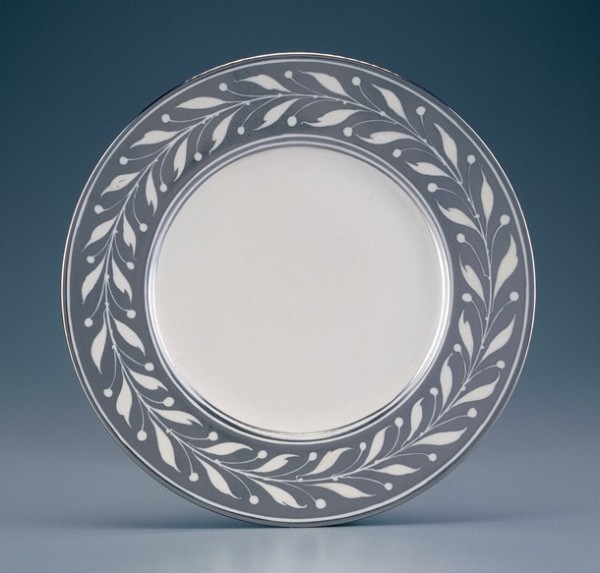
Silver luster plate, 1960–1970. Bone china, with silver on a white ground. D. 10". This example was not made by Thorley, but it was decorated by him.
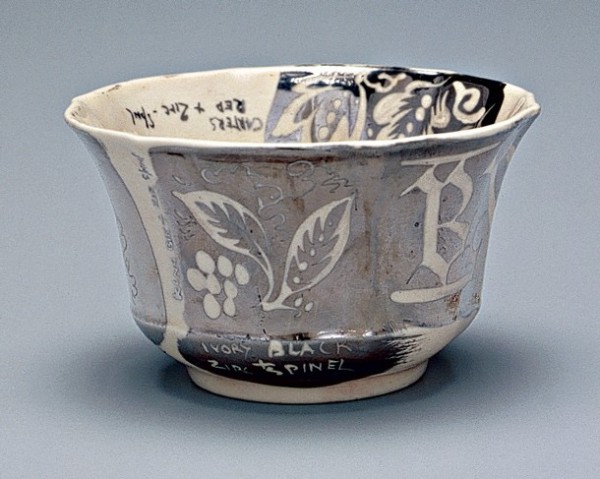
Silver luster sugar bowl, 1960–1970. Bone china, with experimental silver on white ground, covered with many unrelated designs. D. 3 3/4". This bowl has no maker’s mark, but bears many formula names, such as “Kling Ivory black” and “Carters red + Zirc, Spinel.”
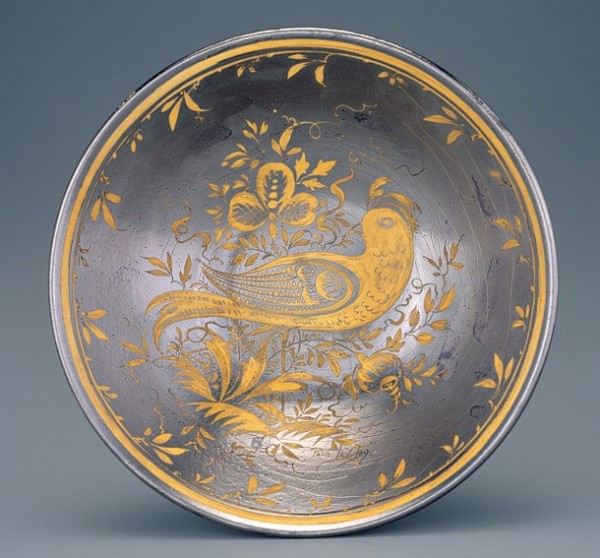
Silver luster bowl, 1960–1970. Earthenware, with silver on yellow ground. D. 8 1/2". Mark: Thorley stamp (illustrated in fig. 10). Here Thorley employs the bird design found on the Thorley Jugs (see fig. 24).

Silver luster sugar and creamer, 1960–1970. Bone china, with silver on white ground. H. of creamer, to top of handle, 3 1/2". Mark: (on both) handwritten, in pink, “Palin Thorley / Williamsburg.” The image shows a finished example of the sugar bowl illustrated in fig. 88.

Silver luster candlesticks, 1960–1970. H. 6". Whiteware, with silver on white ground. Mark (on both): handwritten, in red, “Palin Thorley / Williamsburg.”
